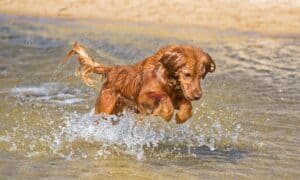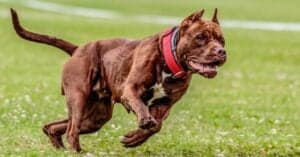Why Thunder Scares Some Dogs, but Not All
@media (min-width: 481px) {
.mobile-top-content {
display: none;
}
}
#mobileTopContentCTACarouselControls { overflow: hidden; text-overflow: ellipsis; white-space: nowrap; }
.mobile-top-content .more { color: #fff; }
.mobile-top-content a { color: #fff; text-decoration: underline; }
.mobile-top-content a:hover { color: #fff; text-decoration: underline; }
@media (max-width: 480px) {
.mobile-top-content {
background-color: #06a10b;
color: #fff;
text-align: center;
/*height: 60px;
padding-top:5px;*/
font-size:80%;
/* display: block; */
margin: 0px -30px;
}
}
When spring comes around each year we tend to find ourselves consoling our dogs during every thunderstorm. We hate to see them running and ducking for cover under the nearest table or bed. Some pet owners find it perplexing that their dogs don’t react this way. Why are some dogs so afraid of thunder, while others seem to have no reaction? Read on to learn more.
There are a few signs to look out for to determine whether or not your dog is afraid of thunderstorms. Besides the obvious ones like running, hiding, or trembling, you might also notice that your dog tends to bark, howl, whine, pace back and forth, or even drool or engage in more destructive behaviors. You might also find him with his ears pointed back, his tail tucked between his legs or low to the ground, and he may be yawning excessively. These are all signs to look out for if your dog has a fear of thunderstorms.
Although it might be easy to spot the signs of your dog behaving anxiously, it might not be so obvious as to why they’re afraid in the first place—especially when some dogs aren’t afraid at all. The reasons why dogs are afraid of thunderstorms can actually get quite complicated.
button.pulse {
transform: scale(1); animation: pulse 2s infinite;
box-shadow: 0 0 0 0 rgba(11, 247, 25, 1);
}
@keyframes pulse {
0% { transform: scale(0.90); box-shadow: 0 0 0 0 rgba(11, 247, 25, 0.5); }
60% { transform: scale(1); box-shadow: 0 0 0 15px rgba(11, 247, 25, 0); }
100% { transform: scale(0.90); box-shadow: 0 0 0 0 rgba(11, 247, 25, 0); }
}
Canine Noise Aversion
The first reason why your dog might be afraid of thunderstorms is due to noise phobias of loud things like construction work, fireworks, and gunfire. A noise phobia can be the main reason why your dog is afraid, or it can just be one of several things that add up to your dog’s intense fear.
Some breeds of dogs like Border Collies or Australian Shepherds are thought to have a genetic predisposition to developing noise phobias such as these. Surprisingly, it is said that at least 40% of all dog breeds will experience some form of noise anxiety.
Unfortunately for your dog, the fear of thunderstorms and other loud noises can worsen over time, especially with regular exposure. This is especially true during the summer months when depending on where you live, there tend to be more storms as well as other loud noises such as fireworks.
Experts aren’t exactly sure what causes noise phobias but there are many theories out there that point to what might be the cause, like the genetic predisposition of certain breeds to be more affected and early trauma experienced when the dog was just a puppy.

Alzbeta/Shutterstock.com
Separation Anxiety
The next thing that could be a significant factor in your dog’s fear of thunderstorms is separation anxiety. This is a very different issue than noise aversion and can exacerbate the issue. Separation anxiety involves your dog’s fear of being left alone. If your dog tends to display signs of anxiousness just as you’re preparing to leave and then becomes thrilled once you’ve returned, it might be an indicator that your dog struggles with separation anxiety.
This condition occurs when your dog is hyper-attached to you and experiences very high levels of stress and anxiety whenever you leave. Because you provide a comforting presence for your dog, it is important that during stressful times for your dog like thunderstorms, you’re there to provide the comfort and safety that it needs if at all possible.
Being gone and away from the dog during a thunderstorm can be a terrifying experience and can even be traumatic, resulting in your dog becoming fearful of being left alone again during another storm. It can begin to become afraid of thunderstorms and associate the negative feeling of being left alone with an impending thunderstorm each time, even without the actual presence of one. This makes it even worse when there is an actual thunderstorm occurring, as your dog might assume that it will be left alone again. Not all dogs suffer from separation anxiety, therefore not all will display this behavior when a storm rolls in.
Static Electricity
This one may come as a surprise, but the reality is that thunderstorms literally charge the air with electricity and this makes it easier for static to buildup in the coat of your dog—especially in larger dog breeds or dogs with longer coats. Dogs that have shorter fur may not be as susceptible to static electricity building up in their coats and therefore may not have the fear of being shocked during thunderstorm activity.
If your dog does get a buildup of static electricity in its coat, it’s easy for it to experience static shocks as it lies on the carpet or if its nose touches anything metal. This can contribute to the development of a full-on phobia of storms and thunder. These small static shocks might even be a part of the reason why your dog might take off running to the basement or another enclosed area in your home when a storm is coming in. This is because those areas tend to be grounded and therefore pose less of a threat of your dog being zapped by static shocks.
What can I do if my dog is afraid of thunder?
Now that we’ve gone over some of the reasons why some dogs are afraid of thunder and others are not, we’ll take a look at some of the things you can do to help lessen your dog’s fear.
Make a Comfortable Spot for Your Dog
The first thing you can try is the simplest thing. It is to let your dog decide where he feels safest and most comfortable when the storm begins. This may be under your bed, at your feet, or in the bathroom. Wherever your dog chooses to hide (as long as it’s safe) let him hide there.
The next thing you’ll want to do is make sure that this place that your dog has chosen is as comfortable as possible. You can do things like making sure that your dog has a comfortable spot to lay, like in a soft bed, you can add things in the room that will drown out the sound, like white noise or any calm, relaxing music. You can also make sure that your dog has access to some of his favorite toys to bring him comfort and provide a distraction from the sound of the thunder.

AJR_photo/Shutterstock.com
Consider Using a Calming Vest
If you’ve tried doing these things already and none of them seem to help, you could consider getting a calming vest for your dog. These vests are designed specifically to provide a light, comforting pressure when worn by your dog that is similar to a baby being swaddled or like a person receiving a hug. The vests use acupressure in a gentle, constant way that helps to relieve anxiety and stress. Most dogs like the feeling of wearing one of these vests and they tend to help quickly reduce your dog’s anxiety during stress-inducing situations.
Consider Taking Your Dog to the Vet
If you’ve tried all of these things and none of them are working for you, you may want to consult your veterinarian. Sometimes fear and anxiety can be brought on by underlying health issues, and if your dog is displaying these behaviors outside of situations that involve loud noises or thunderstorms, you’ll want to have them checked out to rule out any health concerns. Your veterinarian will be able to assess your dog and let you know what the best course of action is for treating your dog’s anxiety. Some of the treatment options may include anti-anxiety medication or canine noise aversion drugs.
If your veterinarian has ruled out any serious health concerns and you want to go a more natural route, you may want to ask about using CBD for your dog. CBD is a natural way to help your dog cope with and manage its stress and anxiety levels, and it’s available in tinctures and treats. It can be administered before a stressful situation so that your dog doesn’t experience the levels of fear and stress that it experienced before.

You can also give certain training techniques a try that have the potential to reverse your dog’s anxiety without the need for medication. When it comes to issues dealing with anxiety or phobias, the most effective types of behavior modifications are desensitization and counter-conditioning.
Counter-conditioning involves teaching your dog to perform positive behaviors instead of being in fear. For example, during a thunderstorm, you could play with your dog and give it some of its favorite treats as a reward for playing instead of running away to hide. This teaches the dog that there is nothing to be fearful of and your dog may even come to associate the sound of thunder with playtime instead of something to be afraid of.
On the other hand, desensitization is a technique that involves controlled exposure to what’s causing the fear. Obviously, we have no control over when a thunderstorm happens, but what you can do is mimic a storm by playing sounds of thunder and storms first on a low volume, and then slowly increasing it as you play with and reward your dog. This is similar to counter-conditioning as it teaches your dog over time to not be afraid of thunderstorms and hopefully to even begin associating them with a positive outcome.
Ready to discover the top 10 cutest dog breeds in the entire world?
How about the fastest dogs, the largest dogs and those that are — quite frankly — just the kindest dogs on the planet? Each day, AZ Animals sends out lists just like this to our thousands of email subscribers. And the best part? It’s FREE. Join today by entering your email below.
More from A-Z Animals
.more-snake-card-image { max-height:140px !important; }
@media (min-width: 481px) {
.mobile-top-content {
display: none;
}
}
#mobileTopContentCTACarouselControls { overflow: hidden; text-overflow: ellipsis; white-space: nowrap; }
.mobile-top-content .more { color: #fff; }
.mobile-top-content a { color: #fff; text-decoration: underline; }
.mobile-top-content a:hover { color: #fff; text-decoration: underline; }
@media (max-width: 480px) {
.mobile-top-content {
background-color: #06a10b;
color: #fff;
text-align: center;
/*height: 60px;
padding-top:5px;*/
font-size:80%;
/* display: block; */
margin: 0px -30px;
}
}
When spring comes around each year we tend to find ourselves consoling our dogs during every thunderstorm. We hate to see them running and ducking for cover under the nearest table or bed. Some pet owners find it perplexing that their dogs don’t react this way. Why are some dogs so afraid of thunder, while others seem to have no reaction? Read on to learn more.
There are a few signs to look out for to determine whether or not your dog is afraid of thunderstorms. Besides the obvious ones like running, hiding, or trembling, you might also notice that your dog tends to bark, howl, whine, pace back and forth, or even drool or engage in more destructive behaviors. You might also find him with his ears pointed back, his tail tucked between his legs or low to the ground, and he may be yawning excessively. These are all signs to look out for if your dog has a fear of thunderstorms.
Although it might be easy to spot the signs of your dog behaving anxiously, it might not be so obvious as to why they’re afraid in the first place—especially when some dogs aren’t afraid at all. The reasons why dogs are afraid of thunderstorms can actually get quite complicated.
button.pulse {
transform: scale(1); animation: pulse 2s infinite;
box-shadow: 0 0 0 0 rgba(11, 247, 25, 1);
}
@keyframes pulse {
0% { transform: scale(0.90); box-shadow: 0 0 0 0 rgba(11, 247, 25, 0.5); }
60% { transform: scale(1); box-shadow: 0 0 0 15px rgba(11, 247, 25, 0); }
100% { transform: scale(0.90); box-shadow: 0 0 0 0 rgba(11, 247, 25, 0); }
}
Canine Noise Aversion
The first reason why your dog might be afraid of thunderstorms is due to noise phobias of loud things like construction work, fireworks, and gunfire. A noise phobia can be the main reason why your dog is afraid, or it can just be one of several things that add up to your dog’s intense fear.
Some breeds of dogs like Border Collies or Australian Shepherds are thought to have a genetic predisposition to developing noise phobias such as these. Surprisingly, it is said that at least 40% of all dog breeds will experience some form of noise anxiety.
Unfortunately for your dog, the fear of thunderstorms and other loud noises can worsen over time, especially with regular exposure. This is especially true during the summer months when depending on where you live, there tend to be more storms as well as other loud noises such as fireworks.
Experts aren’t exactly sure what causes noise phobias but there are many theories out there that point to what might be the cause, like the genetic predisposition of certain breeds to be more affected and early trauma experienced when the dog was just a puppy.

Alzbeta/Shutterstock.com
Separation Anxiety
The next thing that could be a significant factor in your dog’s fear of thunderstorms is separation anxiety. This is a very different issue than noise aversion and can exacerbate the issue. Separation anxiety involves your dog’s fear of being left alone. If your dog tends to display signs of anxiousness just as you’re preparing to leave and then becomes thrilled once you’ve returned, it might be an indicator that your dog struggles with separation anxiety.
This condition occurs when your dog is hyper-attached to you and experiences very high levels of stress and anxiety whenever you leave. Because you provide a comforting presence for your dog, it is important that during stressful times for your dog like thunderstorms, you’re there to provide the comfort and safety that it needs if at all possible.
Being gone and away from the dog during a thunderstorm can be a terrifying experience and can even be traumatic, resulting in your dog becoming fearful of being left alone again during another storm. It can begin to become afraid of thunderstorms and associate the negative feeling of being left alone with an impending thunderstorm each time, even without the actual presence of one. This makes it even worse when there is an actual thunderstorm occurring, as your dog might assume that it will be left alone again. Not all dogs suffer from separation anxiety, therefore not all will display this behavior when a storm rolls in.
Static Electricity
This one may come as a surprise, but the reality is that thunderstorms literally charge the air with electricity and this makes it easier for static to buildup in the coat of your dog—especially in larger dog breeds or dogs with longer coats. Dogs that have shorter fur may not be as susceptible to static electricity building up in their coats and therefore may not have the fear of being shocked during thunderstorm activity.
If your dog does get a buildup of static electricity in its coat, it’s easy for it to experience static shocks as it lies on the carpet or if its nose touches anything metal. This can contribute to the development of a full-on phobia of storms and thunder. These small static shocks might even be a part of the reason why your dog might take off running to the basement or another enclosed area in your home when a storm is coming in. This is because those areas tend to be grounded and therefore pose less of a threat of your dog being zapped by static shocks.
What can I do if my dog is afraid of thunder?
Now that we’ve gone over some of the reasons why some dogs are afraid of thunder and others are not, we’ll take a look at some of the things you can do to help lessen your dog’s fear.
Make a Comfortable Spot for Your Dog
The first thing you can try is the simplest thing. It is to let your dog decide where he feels safest and most comfortable when the storm begins. This may be under your bed, at your feet, or in the bathroom. Wherever your dog chooses to hide (as long as it’s safe) let him hide there.
The next thing you’ll want to do is make sure that this place that your dog has chosen is as comfortable as possible. You can do things like making sure that your dog has a comfortable spot to lay, like in a soft bed, you can add things in the room that will drown out the sound, like white noise or any calm, relaxing music. You can also make sure that your dog has access to some of his favorite toys to bring him comfort and provide a distraction from the sound of the thunder.

AJR_photo/Shutterstock.com
Consider Using a Calming Vest
If you’ve tried doing these things already and none of them seem to help, you could consider getting a calming vest for your dog. These vests are designed specifically to provide a light, comforting pressure when worn by your dog that is similar to a baby being swaddled or like a person receiving a hug. The vests use acupressure in a gentle, constant way that helps to relieve anxiety and stress. Most dogs like the feeling of wearing one of these vests and they tend to help quickly reduce your dog’s anxiety during stress-inducing situations.
Consider Taking Your Dog to the Vet
If you’ve tried all of these things and none of them are working for you, you may want to consult your veterinarian. Sometimes fear and anxiety can be brought on by underlying health issues, and if your dog is displaying these behaviors outside of situations that involve loud noises or thunderstorms, you’ll want to have them checked out to rule out any health concerns. Your veterinarian will be able to assess your dog and let you know what the best course of action is for treating your dog’s anxiety. Some of the treatment options may include anti-anxiety medication or canine noise aversion drugs.
If your veterinarian has ruled out any serious health concerns and you want to go a more natural route, you may want to ask about using CBD for your dog. CBD is a natural way to help your dog cope with and manage its stress and anxiety levels, and it’s available in tinctures and treats. It can be administered before a stressful situation so that your dog doesn’t experience the levels of fear and stress that it experienced before.

You can also give certain training techniques a try that have the potential to reverse your dog’s anxiety without the need for medication. When it comes to issues dealing with anxiety or phobias, the most effective types of behavior modifications are desensitization and counter-conditioning.
Counter-conditioning involves teaching your dog to perform positive behaviors instead of being in fear. For example, during a thunderstorm, you could play with your dog and give it some of its favorite treats as a reward for playing instead of running away to hide. This teaches the dog that there is nothing to be fearful of and your dog may even come to associate the sound of thunder with playtime instead of something to be afraid of.
On the other hand, desensitization is a technique that involves controlled exposure to what’s causing the fear. Obviously, we have no control over when a thunderstorm happens, but what you can do is mimic a storm by playing sounds of thunder and storms first on a low volume, and then slowly increasing it as you play with and reward your dog. This is similar to counter-conditioning as it teaches your dog over time to not be afraid of thunderstorms and hopefully to even begin associating them with a positive outcome.
Ready to discover the top 10 cutest dog breeds in the entire world?
How about the fastest dogs, the largest dogs and those that are — quite frankly — just the kindest dogs on the planet? Each day, AZ Animals sends out lists just like this to our thousands of email subscribers. And the best part? It’s FREE. Join today by entering your email below.














